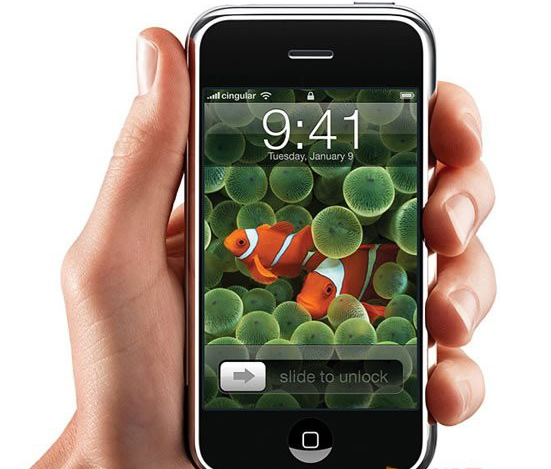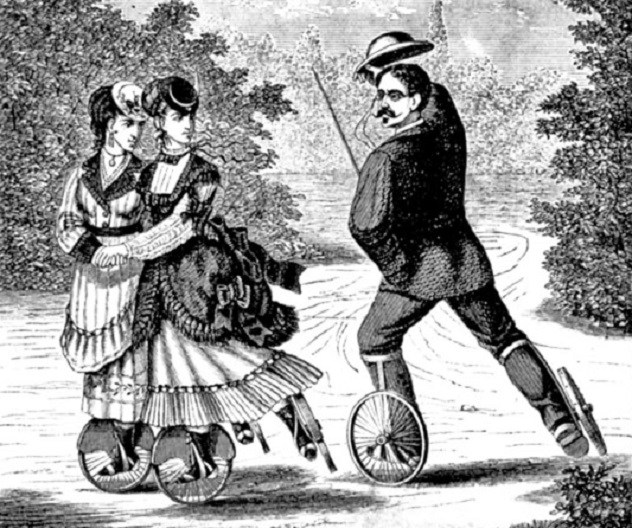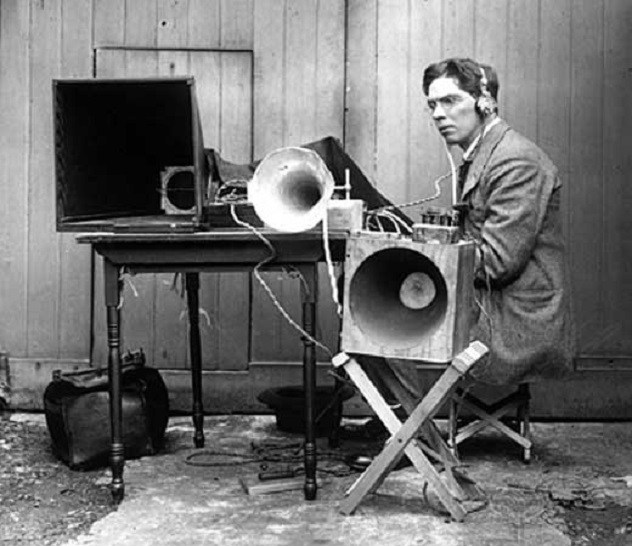Self-driving cars, selfie sticks, drones, touchscreen devices, e-cigarettes, jetpacks, and many other things seem like fairly modern inventions. Indeed, most of their "inventors" list them as newly invented and even go as far as seeking patents. But the fact is, many of these "inventions" have already been in existence for quite some time. They may have earlier lookalikes that ended up not going into production or that went into limited production due to one reason or another. Some also made it into full production but were recalled due to poor sales.
自动驾驶汽车,自拍杆,无人驾驶飞机,触屏设备,电子香烟,喷射背包和许多其他看起来像现代的发明的东西,其实都是老发明。大部分的"发明者"把它们当做新发明,甚至去申请专利。但事实是,这些"发明"已经存在一段时间了。它们都有早期类似的原型,这些早期产品最终没有投入生产,或因为特定原因而限量生产。而有些"发明"得以大批量生产,却因为销售不佳而流产。
10.自拍杆

The first selfie stick was invented long before the first handheld mobile device was made. A selfie stick was definitely invented by the Japanese man Hiroshi Ueda in the 1980s. A photographer and worker at the Minolta camera company, Hiroshi made the selfie stick because he and his wife were unable to take pictures of themselves during a trip to Europe. (When he asked a boy to take pictures of them, the boy ran off with the camera.)
在第一部掌上移动设备发明之前,自拍杆已经问世。自拍杆其实是由一个日本男人上田宏在20世纪80年代发明的。上田宏是美能达相机公司的摄影师,他发明这个自拍杆,是因为他和妻子在欧洲旅行时无法自拍合照。(当时,他叫一个男孩帮他们拍照,那个男孩却拿着相机跑了。)
Frustrated, he invented something that would allow him take a picture of himself: He called it the "extender stick." Since the iPhone really hadn't been invented yet, a small camera was to be attached to one end of the stick. It also had a small mirror in its front so that users could see how they would look in the photograph. He patented the "extender stick" in 1983. The product was mass produced for sale but it was a commercial failure. The quality of the pictures was low. Besides, previous research showed that the women back then were embarrassed by the idea of taking pictures of themselves. The selfie stick was then reinvented by Wayne Fromm in the year 2000, three years before Hiroshi's patent expired. Fromm called his the "quik pod." He believes he is the inventor of today's selfie sticks and has even sued several other selfie stick producers. When asked about Hiroshi's selfie sticks, he said they were "prior art."
万分沮丧之下,他发明了可以允许自拍的东西:他称之为"伸缩杆"。因为智能手机还没发明出来,所以,连接在自拍杆末端的是一个微型相机。在杆的前端有一面小镜子,方便使用者调整他们在相机里的姿态。他在1983年为"伸缩杆"申请了专利。虽然自拍杆进行了大量生产出售,却属商业败笔——相片的质量比较差。另外,以前的研究表明,那时的女士会因自己有自拍的想法而感到尴尬。在2000年,自拍杆被韦恩·弗洛姆(Wayne Fromm)重新发明,那时,上田宏的"伸缩杆"专利期尚有三年。弗洛姆称他的自拍杆为"快捷豆荚"。他认为他才是当今自拍杆的发明者,甚至起诉其他自拍杆生产者。当被问到上田宏的自拍杆时,弗洛姆评论说它们是"先前的艺术"。
9.触屏

In 2007, Apple released the first iPhone: a full touchscreen phone, complete with its own virtual keypad. To many, Apple had done something new, something never seen before. They had made the first touchscreen phone. But this was incorrect: Apple did not make the first touchscreen phone, nor was the touchscreen a new invention.
在2007年,苹果公司发布了第一款iPhone手机:带有虚拟键盘的全触屏手机。对很多人来说,苹果取得了新突破,发明了新事物--他们制造了第一款触屏手机。但这种说法是错误的:苹果不是第一个制造触屏手机的公司,触屏也不是什么新发明。
To start with, a year before the first iPhone was released, LG had introduced a full touchscreen phone. Even that was not the first, though. The world's first touchscreen phone was IBM's Simon, which was released in 1992. And touchscreen technology even predates the Simon. The first touchscreen device was a tablet made by E.A. Johnson in 1965 that was used by air traffic controllers until 1995. Bent Stumpe and Frank Beck made the first capacitive touchscreen in the early '70s. Unlike Johnson's tablet, it could not be pressed with the fingers. Instead, it required a stylus. In 1971, Samuel Hurst developed the first resistive touchscreen, which he called the "elograph." It responded to the fingers as well as a stylus. In 1985, HP invented the world's first touchscreen computer, called the HP-150. In 1993, Apple also released its first touchscreen device—the Newton Personal Digital Assistant. The product was a flop, recording low sales.
其实,在第一部iPhone手机发布的前一年,LG集团已经推出了全触屏手机。虽然那也不是第一台触屏手机。1992年,世界上第一台触屏手机IBM Simon发布。而触屏技术在"西蒙"之前已经出现。1965年,E·A·约翰逊发明了第一个触屏设备——平板电脑,截止到1995年,一直由空中交通管制员使用。本特·斯顿普和弗兰克·贝克(Frank Beck)在20世纪70年代早期发明了电容式触屏,与约翰逊所发明触屏不同的是,它不能用手指操作,而是需要使用触控笔。在1971年,山姆·赫斯特发明了第一台电阻式触屏,他称之为"电子图表"。手指和触控笔都可以对它进行操作。在1985年,惠普公司发明了世界上第一台触屏电脑H-P150。在1993年,苹果公司也发布了第一个触屏设备——牛顿个人电子助理设备。但此产品并不成功,它的销量很低。
8.轮滑

Wheel skates look somewhat like regular inline skates, except that the wheels are much larger, up to the size of bicycle tires. They are seen as a cross between an inline skate, a ski, and a bike. Recently, a company called Chariot Skates said they had come up with something unique—the Chariot wheel skates. According to the company, wheel skates are "revolutionary new skating products." Revolutionary? They do at least revolve. New? No. The first wheel skate was made more than 142 years ago.
轮滑看起来有点像常规的单排轮滑鞋,不过轮滑的轮非常大,尺寸大小跟自行车车轮差不多,看起来像是溜冰鞋,滑雪板和自行车的合体。最近一家名字叫作战车溜冰的公司声称,他们已经有了一些独特的想法——战车轮滑。根据该公司所说,这种轮滑是"革命性的新轮滑产品"。这是一场改革吗?也许是吧,他们至少在改进设计。这是发明吗?不是的。第一双轮滑早在142年前就已存在 。
It even featured in the March 19, 1870, issue of Scientific American magazine. Made by Thomas Luders from Olney, Illinois, and called a "pedespeed," the wheels then were much smaller, measuring around 36 centimeters (15 in) in diameter. Luders also said the skates could be used by anybody, irrespective of their physique. He himself was a large, heavy man, and he claimed he could use them for two straight hours without getting tired. Another version of wheel skates, appearing in 1923, had its tires on the inside of the foot rather than outside. (Other than the size of the wheels, the main improvement made by Chariot Skates is the small tire at the back of the bigger tire for increased stability.)
1870年3月19号,轮滑登上杂志《科学美国人》。它的制作人是伊利诺伊州奥尔尼的托马斯·呂德斯,被称作"佩德速度",后来,轮滑的轮变得小了很多,直径约为36厘米(15英寸)。吕德斯身材高大魁梧,他说自己用轮滑一直滑2个小时也不觉得累,同时他也说每一个人都可以滑轮滑,不论他们是什么体型。另一种轮滑出现在1923年,它的轮子在脚的内侧,而非外侧。(除了轮子的尺寸不一样以外,两种轮滑最主要的差别在于:由战车溜冰公司制作的轮滑,小轮在大轮的后面,增强整个轮滑的稳定性。)
7.无人机

The first drone can be traced back to 1916 when British inventor Archibald Low designed and flew the first unmanned radio-controlled vehicle. The drone was made to counterattack German Zeppelin airships, and it also carried out ground attacks during World War I. It was made with wood and tin, its wings taken from the lower wing of another biplane. Overall, the drone was somewhat unsuccessful because the noise from its engine interfered with its radio. The Sopwith Aircraft Company also tried making a drone in 1916. They placed the radio equipment at the tail so that the engine would not interfere with its signal, but their drone never flew as it was damaged in an accident on the ground. Low would try flying his drone again in 1917 when he flew it in front of some senior military officers. It was launched from the back of a lorry and flew for some time before crashing due to engine failure, almost killing the military officers present.
第一架无线电操纵的无人驾驶飞机可追溯到1916年。英国发明家阿奇博尔德·洛设计并试飞了第一架无人遥控飞机。它是为了反攻德国齐柏林飞艇而制作的,在第一次世界大战中参与了对地面攻击的战斗。无人机由木和锡制成,它的机翼用的是其他双翼飞机的较低机翼。总的来说,无人机是有些失败的,因为它的引擎噪音干扰了无线操作。1916年,索普威斯飞松公司也尝试制作无人机,他们将无线电设备放置在无人机的尾部,这样引擎就不会干扰到它的信号。但因一次地面上的意外事故,他们的无人机再未起飞:当洛操作无人机飞到高级军官面前时,他原本计划会在1917年再次试飞无人机。但无人机从卡车的后面发射后,飞了一段时间便因引擎故障而坠毁,差点要了在场的军官的命。
6.Head-Mounted Computer Displays
6.头戴式电脑出现

In 2012, Google introduced Google Glass, a computer you can wear on your face. Someone wearing the glasses can be walking down the street or doing any everyday task while simultaneously seeing an overlay of calendar appointments, messages, and subway alerts. They can make video calls and even upload live videos to the Internet while on the move, without ever needing to use their hands. Google Glass might be cool, it might be new, it might be revolutionary, but it's definitely not the first pair of wearable computer glasses.
2012年,谷歌发明了谷歌眼镜,一台你能戴在你脸上的电脑。在街上行走或者进行每天的任务的时候戴着它,可以同步看一些覆盖在眼镜上的日程会议,短信及地铁警戒等信息。戴着它行走的时候,可以用它们打视频电话,甚至把直播视频上传到网络,这一切都不需要动手。谷歌眼镜可能挺酷的,挺新颖,还有创新性,但是它绝对不是第一副可佩戴的电脑眼镜。
The first wearable computer glasses were made by Edward Thorp and Claude Shannon in 1961. In 1968, Ivan Sutherland made the "Sword of Damocles." It was the first head-mounted computer display and an early variant of all wearable computer glasses we have today. In 1980, Steve Mann, known today as the father of wearable computing, made the "WearComp", a pair of tech-enhanced glasses that was capable of communicating wirelessly with other computers and could share videos. He continued to work on the glasses over the years, and by 1999, he had come up with a pair of glasses that looked like Google Glass, or rather, that Google Glass looks like. He called it the "EyeTap."
1961年,爱德华·索普和克劳德·香农共同研制出第一副可佩戴的电脑眼镜。1968年,伊凡·苏泽兰制造出了"达摩克里斯的利剑"。这是第一台头戴式电脑,也是今天我们所有头戴式电脑的鼻祖。1980年,史蒂夫·曼恩,被称为"头戴式电脑之父",制造出了"可穿戴式电脑",这种电子增强型的眼镜,可以与其他电脑进行无线沟通以及共享视频。接下来的几年,他在眼镜领域继续研究,而在1999年时,他制造出了一副很像谷歌眼镜的眼镜,或者说谷歌眼镜的原型。他叫它做"电子眼镜"。

















